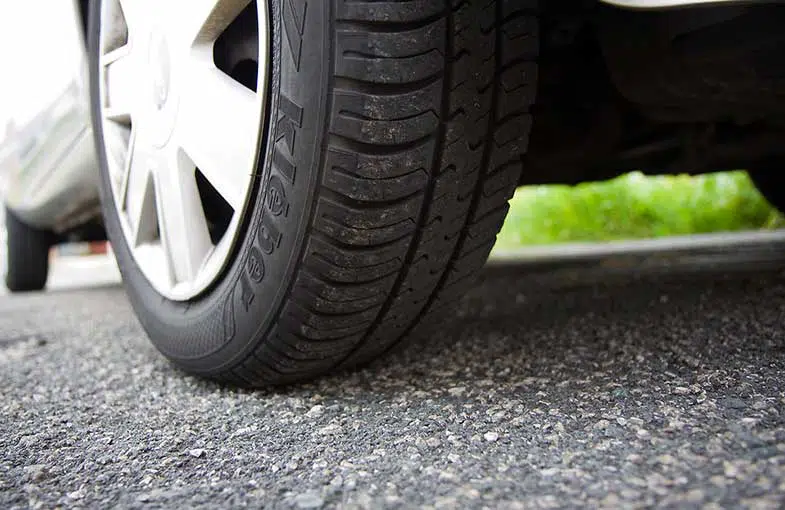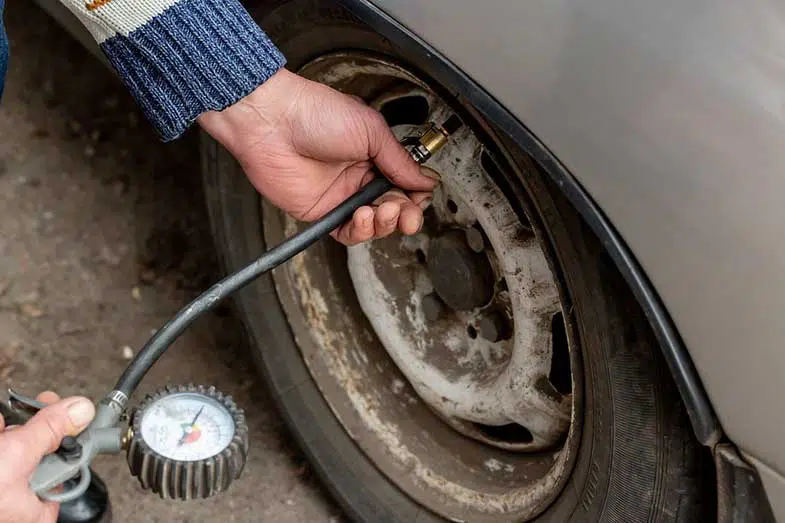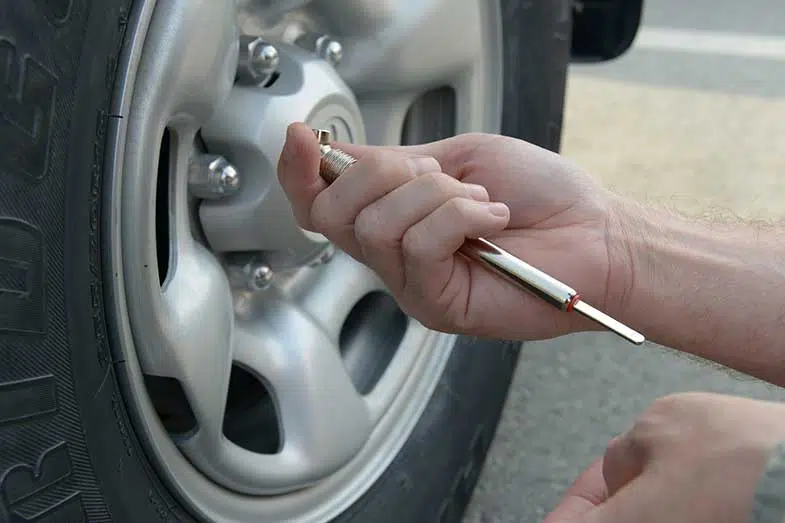Proper tire inflation is often overlooked but is, in fact, the key to prolonging the longevity of your vehicle and your tires. Aside from extending your tire’s life, it also provides a quick steering response, helps you save money on fuel, and keeps you and your passengers safer on the road. Therefore, checking your tire pressure is a smart move.
How often should you check your tire pressure? Check your tire pressure at least once a month to ensure safety and proper tire inflation. It is important to check regularly because your tire pressure drops or increases by one PSI for every ten-degree change in ambient temperature.
In this article, we’ll go over how to check tire pressure, when to check, and more. So if you want to improve your fuel efficiency, save close to $100/year on gas, and ensure that you don’t experience tire blowouts on the road, then read on.

What Affects Tire Pressure
Air pressure in your tires can change substantially depending on outside temperature and season. In the summer, heat can cause the air in your tires to expand and tire pressure to increase by one PSI for every 10°F increase in temperature. Conversely, your tire pressure decreases by one PSI for every 10°F drop in temperature. The most fluctuation can be seen in winter when compounded air pressure loss can drop by five pounds per square inch (PSI). Losing this much air pressure can lead to some vehicle issues if not corrected.
- Wheel and Tire Bead. If your tire pressure leak is not easily detectable, then it may be caused by wheel-bead corrosion. Likewise, imperfections around the sealing surfaces between the rim and beading seat affect your wheel’s overall roundness, resulting in sealing gaps, degradation of your sidewalls, and air in your tires seeping out. I do not advise against die-cast aluminum and magnesium alloy wheels. However, these types are more rust and corrosion-prone than the rest.
- Valve Stem. This fact is not commonly known, but valve stems do deteriorate over time. Road salts and other chemicals cause the plastic and rubber on your vehicle’s tire valve stem to become brittle, eventually leading to small air leaks. Overly tightening the air valve cap can also hasten the stem core’s deterioration. Either this is the reason for air loss, or someone stole one of your valve caps.
- Tire Movement. Cornering, hitting a damaged curb, and other irregularities deform your tire sidewalls, causing them to lose air. Sometimes, it can even lead to several kinds of tire damage like bulging sidewalls, poor sealing, or slashes. Abusing your tires by going beyond the speed limit also creates more friction, leading to an overinflated tire.
- Radiant Heat. When you drive down the road, your tires rub against the asphalt. This occurrence causes friction, which in turn creates heat that makes your air-filled tires expand during summer. An overheating tire is another thing that can effortlessly put you above the recommended PSI for your vehicle. If your tires feel hot to the touch, check your tire pressure and make the necessary tire pressure adjustment without delay. Be sure not to drive until your tires cool down.

Overinflated vs. Underinflated Tires
Some may think that one PSI difference in tire pressure is minuscule and will do no harm. But this thinking is incorrect. Having your tires over or underinflated can be problematic, even hazardous, for you. Overinflated tires are less stable, have less traction, and are more susceptible to a blowout – this is because less tire tread physically touches the ground. On the other hand, underinflated tires add stress to the wheels because the tires have low pressure. Overworked wheels result in hot tires, which lose tread much quicker than properly inflated tires. Furthermore, they can lead to improper handling and breaking and weak vehicle control in bad weather. The tire’s ability to absorb and cushion bumps also drastically reduce, resulting in a firmer and less comfortable ride.
Recommended PSI
Automotive groups base PSI recommendations on various factors such as load index, maximum speed, and ambient temperature. Below is the average recommended PSI based on vehicle type:
- Motorcycles: 28 to 40 PSI
- ATVs: 3-4 PSI for rocky terrain, snow or sand; 7-8 PSI for more hard-packed areas, and running at higher speeds; 5-6 PSI for casual trail riding.
- Passenger cars, SUVs, minivans, and light trucks: 30 to 35 PSI
- 4×4 wagons and UTEs: 30 to 38 PSI
- Buses: 60 to 100 PSI
- Truck: at least 75 PSI
Because tire pressure varies per vehicle, always refer to the PSI recommended for your car and not your tires. The PSI listed on the tire only means the maximum permissible and is not the actual recommendation. Your vehicle’s recommended PSI is indicated in your owner’s manual and on your tire information label. You may also search for this information from a reliable online source. A good practice is checking official manufacturer websites.
When to Check Your Tires
Since your tires lose about one to two PSI every month after you fill them, then as a general rule, check all four of your tires, including your spare, at least once a month, and during large temperature swings. This rule of thumb is applicable regardless if you keep a tire gauge handy, your car includes a Tire Pressure Monitoring System (TPMS), or you have Nitrogen-inflated rubber. Vehicles can tell you when tires need air, but that doesn’t mean that you should entirely rely on that technology. It is best to do proactive tire care and maintenance.
How to Check Tire Pressure
Contrary to popular belief, visual inspection alone is not the right way to check if your tires are under or overinflated. It is not enough that your tires don’t look flat to conclude that they are good enough to last your weekend trip. Relying on this method is not fool-proof and can cost you your safety and hard-earned cash. My recommendation is to do the eye test before you drive and actual tire pressure checks whenever you get gas. Keeping a digital pressure gauge (view on Amazon) in your glove box or center console will make checking tire pressure a breeze.
It is ultimately your choice to go for a standard or digital tire pressure gauge. With a standard type, air pressure pushes a small bar (showing measurement units etched into it) out from the bottom of the pressure gauge, whereas a digital one shows you the reading on a screen. Typically, auto stores and online retailers sell both. There are portable pressure gauges that work as an air compressor at the same time. While for other variants, the tire pressure gauge and air compressor are separate. I highly recommend spending a little bit on a quality tire pressure gauge that provides accurate readings. Alternatively, you can use the air compressor at most gas stations.

Steps
Staying on top of your air pressure is a must since a tire is defined as critically underinflated when it is six to eight PSI below or only filled to about 80% of the recommended cold inflation pressure. To ensure your tires perform optimally, all you need to do is get a tire gauge, air compressor, pen, and paper, and follow these steps:
- Ensure your tires are cold (meaning rested for at least 3 hours before tire pressure check or driven a mile or less at moderate speed). The best-case scenario is to wait until the following morning before you head out to check them.
- Check the manufacturer’s recommended PSI located on the driver’s side door jamb or indicated in your owner’s manual.
- Unscrew the air valve cap – this should be a protruding piece on top of the valve stem.
- Press the gauge to the open valve. If you hear a whistle of air, that is normal.
- Read the gauge and write down each tire’s PSI.
- Adjust the air pressure until it meets the recommended PSI by inflating them with an air compressor like EPAuto 12V DC Portable Air Compressor Pump (view on Amazon) or letting air out.
- After filling the tires, re-check each with your tire pressure gauge to ensure they are not overinflated. Let out air if necessary.
- Repeat this procedure monthly.
When inflating tires on your own, you may need to take several tire pressure tests to ensure that you have all your tires filled correctly. Don’t rush this procedure, as getting air pressure right is crucial. Additionally, consult your dealer, manufacturer, or a tire professional if you cannot find the recommended PSI in your owner’s manual or on your tires.
Tip: If you’re using a gas station air compressor, adjust the proper pressure to four PSI or 14 kPa above the recommended cold inflation pressure. Then re-check later when your tires are cold to make sure they’re right.
What Is TPMS?
Tire Pressure Monitoring System (TPMS) is an electronic system that warns you when there are one or more significantly underinflated tires. It became one of the outcomes after the U.S. government passed the TREAD Act in 2007, in response to a spike in accidents caused by underinflated tires. There are two kinds of TPMS – direct and indirect. Indirect TPMS relies on wheel speed sensors that read wheel revolution data from a car’s anti-lock brake system. Direct TPMS uses monitoring sensors with each tire that monitor specific pressure levels. Both have the TPMS low tire pressure indicator, a yellow, horseshoe-like symbol with an exclamation point that illuminates on the dashboard panel of a vehicle.
Long-lasting batteries power TPMS sensors. But despite being designed to last several years, these sensors eventually lose their charge. Because their dead batteries are difficult to remove, you have no option but to replace the entire sensor. The price of replacement sensors depends on your vehicle, and you can find it from many sources, online retailers, or your local tire store. TPMS sensors need to be replaced at a repair facility and usually cost at least $100 for a set of four.
If your TPMS warning comes on more than once after you have filled your tires with air, one of your tires may have a leak. When this happens, get to a tire store and have your tires repaired immediately. If nothing is wrong with your tires, have your TPMS sensors checked and replaced if needed. Never take chances on driving on a badly underinflated tire as it can cause you to lose control of your vehicle or, worse, get you into an accident.
TPMS Tips:
Always reaffix the valve-stem cap after checking air pressure or inflating the tires to ensure your vehicle’s pressure sensors remain functioning for the longest time possible. Moreover, if you keep a second set of tires for use in winter, make sure to install them with compatible TPMS sensors. Doing this guarantees that you won’t get deflated tires regardless of the season.

More About Tire Pressure
- What is the most common tire pressure? Similar to online search results, the most common PSI is between 32 and 35. On newer cars, a sticker inside the driver’s door shows the recommended PSI.
- What are the signs of low tire pressure? Reduced gas mileage, experiencing a spongy drive, toppling over bumps and ridges without ease, or feeling like your car is drifting to one side of the road are just the telltale signs that your tire pressure is running low.
- Is 40 PSI good tire pressure? Usual tire pressure is between 32-35 PSI when the tire is cold. But if you live in an area where the ambient temperature fluctuates, it is recommended to stay within the 32-35 PSI range. Or better yet, stick to what your owner’s manual says.
- What is the recommended tire pressure for 51 PSI max? The PSI listed on the tire only means the maximum permissible PSI, so you shouldn’t use that as a reference to identify what the correct PSI pressure is. Set your tire pressure to what it says on your door jamb.
- At what PSI will a tire explode? The tire burst pressure is about 200 PSI. So if you went driving at a moderate speed with 30 PSI and it is 59°F outside, it will take the ambient temperature to go up to at least 909°F before your tire bursts. It still depends on your speed, hot weather, and highway conditions that your vehicle goes through.
- Can you drive on a tire with 20 PSI? While a flat tire is considered anything below 20 PSI, it is never advisable to ride on a tire with that tire pressure. It is very close to the limit and could lead to hot sidewalls, rubber breakdown, and a possible tire blowout.
Conclusion – How Often Should You Check Your Tire Pressure?
Thanks to advancements in technology, obtaining tire pressure readings can now take place anywhere. Having a standard or digital tire pressure gauge handy does the job for you, but having a TPMS in your vehicle makes things much better. Still, the general rule applies – you need to check your tire pressure at least once a month. Ideally, more frequent tire pressure checks are preferred, but if you don’t have enough time, they are not required. Be proactive with your tire care and maintenance, and you won’t have to worry about unwanted tire expenses or your safety on the road.
Kris is an avid off-roader and outdoor enthusiast who loves to brave the elements and take on challenging terrain. He also enjoys sharing his passion and knowledge with others so that they, too, can appreciate the ride.
About Kris
